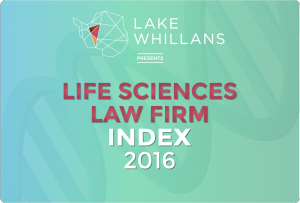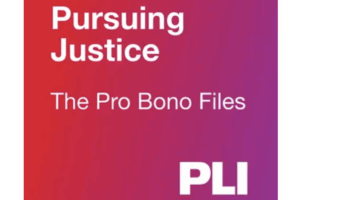 When it comes to fighting disease, Michael Shuster takes things personally. That may be a strange thing to say about a lawyer, but the partner at Fenwick & West — which was recently named one of the top life sciences patent law firms by Lake Whillans, Above the Law, and MedCity News — sees the impact of his work everywhere, from his neighbors to his sister to a friend who recently lost a battle with cancer.
When it comes to fighting disease, Michael Shuster takes things personally. That may be a strange thing to say about a lawyer, but the partner at Fenwick & West — which was recently named one of the top life sciences patent law firms by Lake Whillans, Above the Law, and MedCity News — sees the impact of his work everywhere, from his neighbors to his sister to a friend who recently lost a battle with cancer.
Shuster himself is a trained scientist — as are many of his colleagues at Fenwick’s life sciences practice — with a Ph.D in electrophysiology. San Francisco-based Shuster says he is more excited than at any time in his career by the progress being made, and the key role that patent prosecution plays in getting these crucial technologies to the patients that need them.
Could you talk about your academic background and how it has shaped your approach to the law?

Stand With Survivors: Legal Tools To Make A Real Difference This DVAM
Enhance your legal skills to advocate for survivors of intimate partner violence.
I started out in biophysics, which I think is not that common a discipline for life science patent lawyers. I did my Ph.D at Columbia University, where I studied with Eric Kandel, who in 2000 won the Nobel Prize for work that I had a lot of involvement with. I essentially had two years of medical school curriculum, which gave me a depth that you don’t often see in people who come up through other disciplines. Pharmacology, physiology, histology, all of those core courses that allow me to see problems from a variety of different aspects, and biophysics gave me a quantitative bent that a lot of biologists don’t carry with them.
I did a six-year stint at the University of California, San Francisco after Columbia. In every patent lawyer, there’s a failed experimenter, and I was no exception. I spent a bunch of time trying to grow diffraction-quality crystals of a very large membrane protein that is the molecule that transduces thought into voluntary muscle movement. Through that experience, I learned a lot about membrane protein biochemistry, in addition to X-ray crystallography. You never know and you never can know as you’re studying basic science how it’s going to crop up later.
How is Fenwick unique in the life science patent space?
It’s not just me: It’s other members of the practice who have enormous breadth in science. There is nothing that a client could throw at us that we don’t have very direct, relevant experience with.
One of our clients, Gritstone Oncology, is doing cancer vaccines, but it is a tricky problem. You not only have to leverage the big-data sequencing of stuff from a biopsy, but you have to have heuristics to figure out which of the many mutations coming out of a biopsy should be included in the vaccine. Here’s where we excel, in collaborating across disciplines, between our life science group and the folks in the more high-tech areas. We actually talk to our colleagues. We like each other, we socialize together and we build very strong ties. We have a working group to deal with this crossover work, generating best practices in these very complex crossover technologies. I think we do it better than anyone, hands down. I think we’re smarter, more collaborative and very driven to get this stuff right on behalf of our clients. It plays out in the work we do for Gritstone and for clients like Ancestry.com. When I signed them up, I thought they were a life sciences client, but they’re a software company and actually a crossover client.
What are the most exciting trends you see in your practice?

Pursuing The Pro Bono Story: A Conversation With Alicia Aiken
This Pro Bono Week, get inspired to give back with PLI’s Pursuing Justice: The Pro Bono Files, a one-of-a-kind podcast hosted by Alicia Aiken.
Immuno-oncology is the most exciting stuff we’re doing these days, because of the scientific momentum in that field is breathtaking. It’s transformational. And it gives me enormous optimism.
I’ve got a neighbor across the street who has chronic lymphocytic leukemia. Her husband is an emergency room doctor, but he trained 40 or 50 years ago. It gives me great pleasure to be able to point to him articles reporting some of the early results out of the National Institutes of Health with her patient population—reports with fantastic results. In my view, there’s every reason to be optimistic, especially with slower-growing cancers like these. I don’t think she’s going to die from this.
I’ve got a sister with rheumatoid arthritis. One of our clients, Crescendo Bioscience — which was acquired by Myriad Genetics — is the manufacturer of a diagnostic test that she uses to monitor her disease activity. We wrote the patent for that test successfully. I see this playing out in very personal ways. I feel very blessed and very fortunate to have my finger on the pulse, to see what’s coming down the pike.
Why is the life sciences sector doing so well right now?
You’re starting to see some previously intractable problems starting to yield. Look at the cure of Hepatitis C: That was unthinkable 10 years ago.
I am awestruck at the progress that’s being made. Cancer is a terrible foe, a horrible adversary. But for the first time in my career there’s a sense of palpable excitement and momentum, especially in leukemia and lymphoma. What we’re learning in immuno-oncology, coupled with the enormous push for liquid biopsies that clients of ours like Grail Inc. are working on, there’s every reason to be optimistic. I really do feel like our group is contributing to the work that we’re doing for this incredible client base. They make me feel like I’m doing something important. I feel a sense of purpose and like I’m contributing to solving some of the worst, most pernicious problems people face.